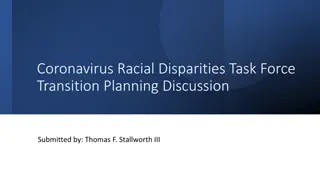Understanding Racial Disparities and Injustice in America
Delve into the critical examination of racial disparities and injustice in America's criminal justice system through works like "The New Jim Crow" by Michelle Alexander. Explore the impact of mass incarceration, societal labeling, and historical contexts that perpetuate racial caste systems. Engage in discussions, self-education, and seek further resources to address racism's roots and manifestations in the present.
Download Presentation

Please find below an Image/Link to download the presentation.
The content on the website is provided AS IS for your information and personal use only. It may not be sold, licensed, or shared on other websites without obtaining consent from the author. Download presentation by click this link. If you encounter any issues during the download, it is possible that the publisher has removed the file from their server.
E N D
Presentation Transcript
Our role at KUMC Educate ourselves and practice talking about racism and racial disparities Small Groups/ Peer facilitators Spectrum of learning no endpoint Seek out additional support (books, videos, groups) We have not faced our racial history and cannot tell the truth about our racial present. Moving on to intense topics Healing space Michelle Alexander
The New Jim Crow Mass Incarceration in the Age of Colorblindness By Michelle Alexander
We use our criminal justice system to label people of color criminals and then engage in all the practices we supposedly left behind. Once labeled a felon, Americans are subject to legalized discrimination: Employment discrimination Housing discrimination Denial of the right to vote Denial of educational opportunity Denial of public benefits (including food assistance) Exclusion from jury service We have not ended racial caste in America; we have merely redesigned it. More Black males are under the control of the criminal justice system now than were enslaved in 1850.
2020 1964 1619 1865 Age of Slavery Segregation Colorblindness 1779 1699 1659 1739 1819 1859 1899 1939 1979
Racism in 2020 39th Street KCMO
Civil Rights Legislation Emancipation Populist Movement Civil Rights Movement Bacon s Rebellion Poor People s Movement Reconstruction 1900 1870 1998 1845 1885 1920 1960 1968 1978 2020 Slavery & Racial Bribe Jim Crow Segregation Southern Strategy Law & Order Rhetoric War on Drugs Mass Incarceration Redemption
Civil Rights Legislation Emancipation Populist Movement Civil Rights Movement Bacon s Rebellion Poor People s Movement Reconstruction 1900 1870 1998 1845 1885 1920 1960 1968 1978 2020 Slavery & Racial Bribe Jim Crow Segregation Southern Strategy Law & Order Rhetoric War on Drugs Mass Incarceration Redemption Movement to Reject Caste Multiracial Alliance Racial Caste Racial Bribe Racial Progress New Caste New Bribe Backlash
Ronald Reagan 1982 Less than 2% of Americans viewed drugs as the most important issue facing the nation Drug use was stagnant Federal anti-drug funding from $8 million in 1980 to $95 million in 1984, yet money for treatment and prevention was cut by Media campaign to sensationalize the use of crack cocaine (which increased only after the war on drugs) The War on Drugs 1980s
1992 Bill Clinton escalated the drug war Tougher on Crime Increased sentencing for drug crimes Increased spending for corrections and slashed spending for housing and welfare Reduced rights for drug-felons to get Housing Jobs Food stamps The War on Drugs 1990s
Fourth Amendment Rights search and seizure Supreme Court interpretations Stop and frisk majority people or color Pretext traffic stops majority people of color Financial incentives Money to police for numbers of drug arrests Byrne grant program Cash and property forfeiture laws Fed anti-drug spending from $8M to $95M Militarization of police Free supplies and training Use of SWAT teams in drug raids homes, public housing, schools (1970s 300/yr 1990s 30K/yr) The War on Drugs
Police regularly stop and search people absent of criminal or dangerous behavior Many people never meet with a lawyer (or spend a few minutes) Very few people actually go to trial Plea deals to avoid severe minimum sentences Witnesses are coerced by reduced charges Most people are trapped for life in the closed circuit of perpetual marginality Criminal Justice System Realities
Honor Confidentiality Small Groups Choose courage over comfort Regard feedback as a generous gesture that should always be met with gratitude
Discussion Questions 1. What stands out to you from the reading or today s presentation? Did the anything challenge your beliefs about race, racial progress, and our criminal justice system? How does our legal system reinforce systemic racism? 2. What strategies have politicians /wealthier white people used to divide poor white people and Black people in the past? Do you see similar divide and conquer dynamics at work today? 3. Why are more Black males under the control of the criminal justice system now than were enslaved in 1850? How do we make sense of this knowledge? 4. The author highlights how the interpretation of the Fourth Amendment by the Supreme Court has effectively eviscerated search and seizure protections, particularly in the drug context. Were you aware of this? Have you observed public outcry over the restriction of Fourth Amendment rights (why/why not)? 5. How do you think the incentives created by the War on Drugs grant programs and laws about forfeiting property affected policing strategies and Black communities?























